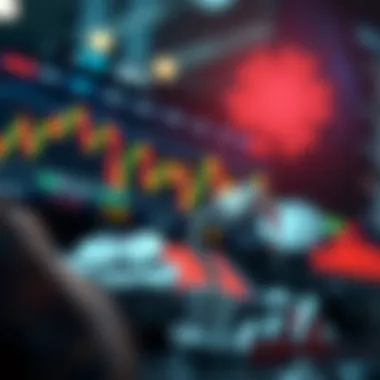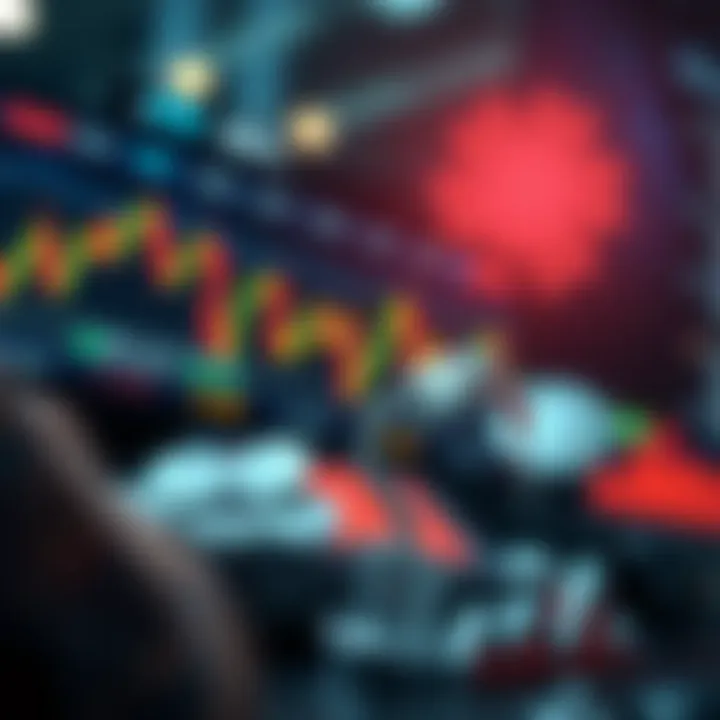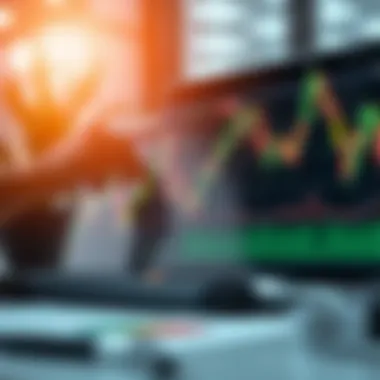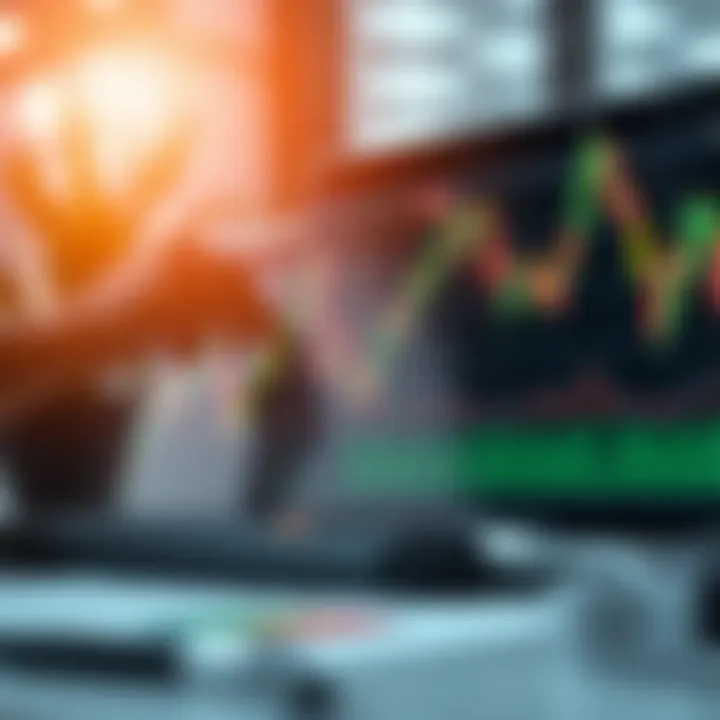Understanding Silver Futures Trading Dynamics


Intro
Futures trading provides a thrilling ride through the financial markets, and when it comes to silver, the experience can be both lucrative and perilous. Investors consult the silver market for various reasons, whether it’s to hedge against inflation, speculate on price movements, or diversify their portfolios. At its core, silver futures trading consists of entering contracts that promise to buy or sell silver at a predetermined price on a future date. Grasping the nuances of this marketplace can seem daunting, but understanding key concepts demystifies the process.
In this article, we will explore market dynamics that drive silver prices, unveiling effective strategies for trading, and discussing risk management techniques essential for thriving in this exciting environment. Perfect for investors across the spectrum—whether experienced or novices—this guide aims to equip you with the knowledge needed to navigate the silver futures trading landscape with confidence.
Investment Understanding
Understanding the landscape of silver futures trading is not just about knowing how to place trades, but also about grasping the fundamental aspects that influence the market. This section serves to clarify key terminology and the types of investments available in this sector.
Key Terms Explained
Before diving into the market, it's crucial to familiarize yourself with specific terminology. Here are some key terms that every silver investor should know:
- Futures Contract: A legal agreement to buy or sell an asset at a predetermined price at a specified time in the future.
- Margin: The portion of the investment that must be deposited to open a futures position. It acts as a good-faith deposit to cover potential losses.
- Hedging: A strategy used to offset potential losses in investments by taking an opposite position.
- Speculation: The act of buying and selling assets to profit from price movements, often involving higher risk.
Types of Investments
When it comes to investing in silver, various avenues exist beyond traditional futures contracts:
- Silver ETFs: Exchange-traded funds that offer exposure to silver without the need for physical possession. They track silver prices and can be traded like stocks.
- Physical Silver: Investing in silver bars, coins, or rounds directly. This requires storage and security considerations.
- Mining Stocks: Shares in companies that mine silver can provide exposure to silver’s price movements, along with growth potential from the company’s performance.
Understanding these categories and terms will enhance clarity as we proceed further into the discussion of silver futures trading.
Financial Product Insights
Investors should examine the various financial products available for silver trading. Each has its own set of features and potential risks. This section provides a detailed review of these products, aiding in informed decision-making.
Comprehensive Reviews
Silver futures contracts are primarily traded on exchanges, with the COMEX division of the Commodity Exchange being one of the most notable. Each contract represents a specific amount of silver and is standardized, allowing for easy liquidation. On the other hand, silver ETFs like the iShares Silver Trust provide a different kind of flexibility, allowing investors to easily buy and sell shares without dealing with the complexities of futures contracts.
Comparison of Investment Tools
To make an informed choice, one must compare the different investment tools:
- Futures Contracts offer high leverage but also come with higher risk due to margin calls.
- ETFs provide a lower risk profile, are easier to manage, and are less volatile than futures by nature.
- Physical silver investments require storage and carry additional costs but provide intrinsic value and ownership.
"Deciphering the complexities of financial products can illuminate the path to successful investing."
By evaluating these options, investors can select the tools that align with their financial goals and risk tolerance.
Intro to Silver Futures Trading
Silver futures trading is an impactful aspect of the broader financial market, capturing the interest of diverse investors from hobbyists to professionals. This section aims to underscore the importance of understanding silver futures, focusing on the nuances, benefits, and critical considerations entailed in trading these contracts.
First and foremost, silver has a historical significance as a store of value and a precious metal. Unlike stocks or other financial instruments, silver offers a unique opportunity for diversification in an investment portfolio. Investors often turn to silver futures as a way to manage risks associated with price fluctuations. The ability to lock in prices for future delivery can provide a buffer against volatile market conditions, especially in times of economic uncertainty.
Benefits of Silver Futures Trading
Engaging in silver futures trading has several distinct advantages:
- Leverage: Traders can gain significant exposure to silver prices without needing to invest the full amount upfront, purchasing contracts that reflect a larger quantity of silver.
- Hedging Opportunities: Producers and consumers in the silver market can use futures to hedge against unfavorable price movements, allowing for a more stable business environment.
- Liquidity: The silver futures market tends to have high liquidity, enabling traders to enter and exit positions without significant price movements affecting their trades.
However, it's essential to navigate this landscape with care. Futures trading involves a myriad of terms and comprises several components that may confuse those unfamiliar with the market. Understanding margin requirements, contract specifications, and expiration dates is crucial. Failing to grasp these concepts can lead to financial pitfalls.
"Knowledge is the key; know the risks and rewards of silver futures to create a balanced trading strategy."
Moreover, as silver prices can be influenced by various external factors—such as geopolitical tensions, economic shifts, and changes in supply and demand dynamics—tuning in to market news and analysis becomes paramount for successful trading.
In summary, delving into silver futures trading opens doors to potential opportunities while demanding sound knowledge and strategic thinking. With the rise in interest for alternative investments, understanding this area will cultivate a more informed investor base, ready to tackle both the challenges and benefits of trading silver futures.
By establishing a solid foundation in the matters outlined above, investors can prepare themselves for the elaborated discussions on futures contracts in the upcoming sections.
Understanding Futures Contracts
Futures contracts are the backbone of commodity trading, and grasping their mechanics is crucial for anyone looking to venture into silver futures. They are not merely pieces of paper; these contracts symbolize a commitment to buy or sell silver at a predetermined price on a specific future date. Understanding the principles of futures contracts can significantly influence trading strategies and risk management approaches. In essence, they provide stability in a marketplace that can often resemble a roller coaster ride—full of unexpected twists and turns.
Definition and Purpose
A futures contract serves as a legal agreement between two parties, typically a buyer and a seller. The key function of these contracts is to hedge against price volatility. When an investor enters into a silver futures contract, they lock in a price for the commodity, which can ultimately protect them from fluctuations in the market.
The importance of futures contracts expands beyond simple speculation. They allow producers and consumers to manage risk, making them integral to the commodity trading landscape. By knowing the future price, traders can budget and make informed decisions about production levels or inventory turnover.
- Key Points about Futures Contracts:
- Standardization: Futures contracts are standardized agreements traded on exchange, meaning they have consistent terms and conditions.
- Leverage: Investors can control larger amounts of silver with a smaller initial capital investment due to leverage.
- Liquidity: These contracts typically have higher liquidity, enabling traders to enter or exit positions more easily.
In summary, the purpose of futures contracts goes hand in hand with their definition—they facilitate trading while simultaneously providing a buffer against market pressures. Their design allows for both risk management and speculative trading, making them indispensable in the silver futures market.


How Silver Futures Work
Understanding how silver futures operate is essential for any serious investor.
Once you enter a contract, you can either take a delivery of silver or liquidate your position before the contract settles. Here’s how it generally unfolds:
- Entering the Contract: An investor commits to buying or selling silver at a specified price for a future date, often paying a margin.
- Price Movement and Mark-to-Market: The trade can then be settled on a day-to-day basis. As prices fluctuate, profits or losses will be added or deducted from your margin account.
- Expiration and Settlement: As the expiration date approaches, traders can either close their position or opt for physical delivery—though most traders prefer cash settlement to simplify the process.
Silver futures trading also allows you to benefit from both up and down price movements. Whether you believe the market will rise or fall, there's a trading strategy that can align with your market sentiment. For instance, if you anticipate a decline in silver prices, you could take a short position, essentially betting against the metal.
Also, as with any financial instrument, understanding the Underlying Asset is vital. The price of silver futures is influenced by various factors, including:
- Global Economic Conditions: Interest rates and inflation can push silver prices up or down.
- Market Demand: Industrial demand for silver can impact prices deeply.
- Speculative Interest: Trader sentiments can create notable changes in market dynamics.
Market Dynamics Influencing Silver Prices
Understanding how various factors impact silver prices is crucial for any individual looking to engage in silver futures trading. The interplay between market dynamics not only shapes pricing but also defines investment strategies and risk management. A deep dive into these dynamics helps traders, investors, and finance professionals make informed decisions.
Global Economic Factors
The global economy acts as a significant backdrop in determining silver prices. Various elements, such as inflation rates, interest rates, and currency fluctuations, can sway silver's value. When inflation rises, investors often flock to silver as a hedge, driving up demand and price. Conversely, a strong U.S. dollar can have a knack for pushing silver prices down as it makes the metal more expensive for buyers using other currencies.
Furthermore, economic growth metrics, like GDP figures, also have their say. A robust economy may reduce the allure of silver as an investment, while recessions tend to send traders scrambling for safe havens like silver.
"Understanding these global economic indicators is akin to reading tea leaves for a good trader; knowing when to react can mean the difference between profit and loss."
Supply and Demand Dynamics
At the heart of commodities trading is the fundamental rule of supply and demand. For silver, the balance here fluctuates based on industrial demand, investment demand, and mining outputs.
- Industrial Demand: Silver finds its way into numerous applications from electronics to solar panels. As technology evolves, so does the demand for silver, notably in green technologies.
- Investment Demand: When the market gets jittery, it's not unusual for investors to hasten to silver as a way to preserve wealth.
- Mining Outputs: The availability of silver directly derives from mining. Significant discoveries or disruptions due to strikes can stir the market, modifying supply levels and subsequently impacting price.
Tracking these supply and demand metrics is indispensable for traders aiming to foresee price alterations ahead of time, as they can often act as leading indicators in the market.
Geopolitical Events
Geopolitical landscapes can make silver prices do the tango. Political instability or conflict often sends tremors through the markets. In times of unrest, silver tends to shine brighter, seen by many as a reliable store of value amidst chaos. For instance, conflicts in major mining regions can restrict supply, leading to sudden price spikes.
Moreover, trade relations—even rumors of tariffs—can impact silver pricing by altering production costs or influencing demand around the globe. For example, when new tariffs hit silver imports, traders might perceive a potential scarcity, spurring immediate demand followed by price increases.
In sum, being attuned to global happenings is vital for making tactical trading decisions in the silver futures market, as many investors rely on these signals to strategize their moves effectively.
Key Terms in Silver Futures Trading
Understanding key terms in silver futures trading is crucial. They not only help investors navigate the murky waters of the trading landscape but also provide insights necessary for making informed decisions. Without a solid grasp on the terminology, it can feel like wandering through a maze. Key terms act as important signposts, guiding traders toward successful outcomes and mitigating potential pitfalls.
Margin Requirements
Margin requirements are like the entry fee at a carnival, but instead of a few bucks, they often involve a percentage of the total contract value. When engaging in silver futures trading, investors must deposit a margin, which is essentially a good-faith collateral to cover any potential losses. This margin is typically a fraction of the full contract value, and it serves to ensure that parties can fulfill their obligations.
For example, if a silver futures contract is worth $25,000 and the broker requires a 5% margin, the trader must put down $1,250. This keeps both parties in check and adds a layer of security to the trading process. However, it's crucial to be aware that margin trading amplifies both potential gains and potential losses. Just like betting on a horse, you could hit the jackpot or walk away empty-handed. Longer-term swings in market price can lead to margin calls, prompting the trader to deposit more funds, adding further complexity to trading strategies.
Contract Specifications
Contract specifications lay down the law in silver futures trading. They include details such as the contract size, tick size, and delivery months. Each specification is formulated to ensure traders have clear expectations.
For instance, a standard silver futures contract usually represents 5,000 troy ounces. Knowing this is key when deciding how much to invest and how many contracts to trade. Tick size, defined as the minimum price movement, often hovers at $0.005. Understanding these terms allows investors to calculate potential profits or losses more accurately. Moreover, the various delivery months outlined in the specifications can be strategic benchmarks for traders looking to stake their claims or roll over contracts.
In essence, a comprehensive knowledge of contract specifications allows investors to measure risk and return more effectively. Ignorance here can lead to misguided assumptions about potential profit or high exposure to losses at the end of a trading cycle.
Expiration Dates
Every futures contract carries an expiration date, marking the moment the agreement is fulfilled. In silver futures trading, this date is essential for traders as it signifies the end of a contract's life cycle.
The significance of expiration dates cannot be overstated. For instance, if a trader holds a position as the expiration date rolls around, they will either have to close the position or settle in cash. Settling in cash means that the trader will receive the cash equivalent of their contract; however, if they're hoping to take physical delivery of silver, holding until expiration could require additional actions—like locating a reliable delivery method.
Failing to grasp the implications of expiration dates can result in unexpected costs or losses. Furthermore, it may necessitate adjusting trading strategies based on the timeline. A well-structured plan that incorporates expiration awareness enhances traders' odds of navigating market fluctuations with agility.
"In the world of trading, knowledge is your most effective strategy."
Analysis Techniques for Trading Silver Futures
In the realm of silver futures trading, analysis techniques serve as the compass guiding investors through the often turbulent waters of the market. These methods not only enhance decision-making but also empower traders to gain insights into market movements, identify potential opportunities, and ultimately tailor their strategies to optimize returns. Understanding how to effectively analyze the silver market can mean the difference between fortune and folly. Here, we delve into three primary types of analysis: fundamental, technical, and sentiment analysis.
Fundamental Analysis
Fundamental analysis is akin to examining the roots of a plant—getting to the very essence of what drives an asset's value. In the case of silver, this includes scrutinizing economic indicators, geopolitical stability, and supply and demand fundamentals. For starters, macroeconomic data such as interest rates and inflation play integral roles in determining silver prices. When interest rates are low, silver becomes more attractive compared to interest-bearing assets since it doesn’t yield a return on its own. Additionally, global economic conditions, reflected in data like GDP growth rates and employment numbers, can sway investor interest toward or away from silver.


Moreover, one must not overlook the impact of industrial demand on silver prices. The metal is widely used in electronics, solar panels, and medical instruments. Understanding these industrial trends can provide vital insights for forecasting price movements. In other words, knowing whether the demand from industries like technology and manufacturing is on the rise or decline is crucial for accurately predicting silver price trajectories.
"Investment is not just about numbers, it’s about understanding the stories behind the numbers."
Technical Analysis
Technical analysis, in contrast, is more like a treasure map, highlighting the paths that traders have taken before. It relies primarily on charts, patterns, and statistical metrics to predict future movements based on historical price action. Tools such as moving averages, relative strength index (RSI), and candlestick patterns help traders identify trends and potential reversal points.
For instance, moving averages smooth out price data to create an actionable insight over specific periods, allowing traders to gauge whether a trend is bullish or bearish. Similarly, the RSI assists in identifying overbought or oversold conditions in the market. Traders who harness these tools can anticipate market movements and make strategic decisions accordingly. However, one must note that while historical patterns can offer guidance, they do not guarantee future results, making it essential to combine technical insights with other analyses.
Sentiment Analysis
Sentiment analysis dives into the emotional facets of trading, capturing the mood and psychology of market participants. This approach evaluates how the collective sentiment of investors—bullish or bearish—can drive price movements. Tracking news trends, social media discussions, and market reports helps one get a pulse on public perception regarding silver trading. An asset can often rally based on excitement and optimism driven by favorable news or plummet due to fear and uncertainty brought on by geopolitical events or economic downturns.
Understanding sentiment can be particularly valuable during periods of high volatility or uncertainty. For instance, if a sudden geopolitical event threatens supply chains, observing shifts in sentiment can help a trader position themselves advantageously ahead of price fluctuations. By gauging the market’s mood, traders can make more informed decisions that align with prevailing market sentiments.
Trading Strategies for Silver Futures
Trading strategies play a vital role in the landscape of silver futures, allowing investors to navigate the volatile and often unpredictable nature of the market. Understanding the various approaches to trading silver futures can enhance investors’ capacity to make informed decisions. Each strategy comes with its own set of considerations, benefits, and potential pitfalls.
By tailoring strategies to their own risk tolerance and investment goals, traders can optimize their positions in silver futures. These strategies vary from short-term, which hinge on quick movements in price, to longer-term methods that focus on sustained trends. When deployed effectively, they can provide a comprehensive framework for managing trades and maximizing returns.
Short-Term Trading Approaches
Short-term trading in silver futures often appeals to those looking to capitalize on swift market movements. Day trading and swing trading are two popular approaches within this category. Here’s a closer look at them:
- Day Trading: This strategy involves buying and selling silver futures within the same trading day. Traders rely heavily on technical analysis, price action, and market news to make quick decisions. It requires a keen eye and swift execution, as even a minute can change the landscape significantly.
- Swing Trading: Unlike day trading, swing trading sees positions held over a few days or weeks. Traders aim to capture short-term price movements and rely on both technical indicators and fundamental analysis. It’s a more relaxed approach compared to day trading, suitable for those who can’t monitor the markets constantly.
Short-term trading can lead to substantial gains but also comes with heightened risk. It’s not uncommon for traders to face significant losses if they misinterpret signals or if market conditions shift unexpectedly. Thus, adequate risk management strategies are crucial.
Long-Term Holding Strategies
On the flip side, long-term holding strategies offer a different approach to silver futures trading. This method is grounded in the belief that, despite short-term fluctuations, silver often trends according to broader economic factors. In this light, there are a few key components:
- Buy and Hold: Investors purchase silver futures contracts with the expectation that the price will appreciate over time. This approach relies more on fundamental analysis, focusing on the long-term demand for silver as an industrial metal and a store of value.
- Dollar-Cost Averaging: This strategy involves regularly investing a fixed amount, regardless of silver prices. Over time, this can reduce the impact of volatility and spread the risk, while allowing investors to build their position gradually.
Holding positions over a longer period can eliminate concerns about daily market fluctuations and create a stronger position for capitalizing on potential price increases.
Hedging with Futures
Hedging is a strategy often utilized by traders and companies looking to manage their risk exposure to price movements in silver. Here’s how this works:
- Purpose: Investors can hedge against price declines by taking a position in silver futures that offsets their physical silver holdings or other investments linked to silver. This strategy helps lock in prices and protect against adverse price swings.
- Example: A jewelry manufacturer may purchase silver futures contracts to lock in the price of silver they will need in the future. By doing this, they safeguard their profit margins against fluctuations in silver prices.
Hedging, while risk-reducing, requires a clear understanding of one’s exposure and the dynamics of futures markets. It’s often considered a more sophisticated strategy reserving for experienced traders and those with reputable knowledge in commodities.
In summary, diversifying one's approach with a blend of short and long-term strategies, along with hedging, can lead to a more robust silver futures trading experience. Each method has its merits, and ultimately, the key remains in aligning the strategy with personal risk tolerance and market analysis. Stick to a plan, keep learning, and monitor the silver landscape for any changes.
Risks Associated with Silver Futures Trading
Silver futures trading is not without its pitfalls. It’s essential for traders to grasp the risks that accompany this trading landscape. Understanding these elements not only equips investors with the knowledge necessary to navigate the complex world of silver but also aids in crafting strategies that can mitigate potential losses. Here, we delve into some common risk categories that traders face.
Market Risks
Market risks loom over silver futures trading like a dark cloud. They are inherently tied to the volatility of silver prices, which can swing rapidly due to varying factors. Imagine waking up one morning to discover that the price of silver plummeted overnight. This could happen for several reasons:
- Economic Data Releases: Key reports on employment rates, inflation, or GDP can influence trader sentiment and, consequently, silver prices.
- Market Sentiment: Overall market mood can fluctuate based on news, political events, or even social media chatter, affecting investment decisions.
- Competitor Commodities: Changes in gold prices, another precious metal, can draw investment away from silver, impacting its market value.
Therefore, traders must remain vigilant, keeping abreast of global economic news and trends to manage the risk presented by market fluctuations. A well-thought-out risk management plan is not just sensible; it’s imperative.
Liquidity Risks
Liquidity refers to how easily an asset can be bought or sold without causing drastic changes in its price. In silver futures trading, liquidity risks can manifest in several ways, leaving traders in a pinch. Perhaps they want to exit a position, only to find that there aren’t enough buyers available. This can lead to forced selling at unfavorable prices, which is a nightmare for any trader.
A few considerations related to liquidity risks include:
- Thin Markets: Certain times of the day or periods of low trading volume can create thin markets, making it hard to get trades executed without affecting the price.
- Order Types: Using market orders instead of limit orders can expose traders to liquidity risks, especially during volatile price movements.
- Economic Events: Announcements that can affect silver supply or demand may lead to sudden spikes in trading volume, resulting in decreased liquidity.
Keeping a sharp eye on market conditions and understanding the order types can help mitigate these liquidity risks.
Operational Risks
Operational risks are often the unsung heroes in the realm of trading risks. They stem from the internal processes and systems involved in executing a trade. These can range from technical issues with trading platforms to errors in trade execution. Consider this:
- Technical Failures: Glitches in trading platforms can occur at the most inconvenient times, possibly resulting in missed opportunities or worse, unintended trades.
- Human Error: Mistakes during manual entry of trade data could lead traders to make poor decisions, possibly losing more than anticipated.
- Counterparty Risks: This arises when a party involved in the trade fails to meet contractual obligations. In an extreme scenario, this could lead to financial losses.
To combat operational risks, traders can adopt multiple strategies, including maintaining robust IT systems, conducting regular training sessions, and sticking to a comprehensive checklist before executing trades.


The careful assessment of these risks not only aids traders but also enhances their overall proficiency in managing silver futures trades. By understanding market, liquidity, and operational risks, one can approach trading with more confidence and, ultimately, success.
Thus, keeping these risks in mind is crucial when stepping into the world of silver futures trading. Each risk presents a unique challenge, making awareness and preparedness vital for traders aiming to thrive in this complex landscape.
Relevant resources for more insight:
- Investopedia
- Commodity Futures Trading Commission
- Wikipedia on Futures Contract
- Silver Trading Community on Reddit
Understanding and navigating these risks effectively puts traders a step ahead in the highly competitive silver futures market.
Regulatory Environment for Futures Trading
The regulatory environment surrounding futures trading is crucial in maintaining order and integrity within the markets. In the case of silver futures, regulations not only protect market participants but also promote transparency and fairness. This, in turn, encourages more investors to make informed decisions about their trading strategies.
Key Regulatory Bodies
When it comes to the silver futures market, several regulatory bodies are pivotal in overseeing trading practices. Here are some significant ones:
- Commodity Futures Trading Commission (CFTC): This U.S. government agency plays a central role in regulating futures trading. Its primary goal is to protect market participants from fraud, manipulation, and abusive practices. The CFTC also ensures that market participants follow fair trading practices, which are fundamental for the integrity of the silver futures market.
- National Futures Association (NFA): The NFA is another key player in the regulation of futures trading. This self-regulatory organization establishes rules that its members must adhere to, contributing significantly to the industry's professionalism. They monitor trading activities and conduct audits to ensure compliance with established regulations.
- Financial Industry Regulatory Authority (FINRA): Though it primarily oversees the securities industry, FINRA’s influence extends into futures trading. FINRA ensures that firms and their personnel meet the required standards, thus indirectly affecting the silver futures market by safeguarding overall market practices and benefiting investors.
Understanding these regulators can significantly inform a trader's approach. Complying with their rules and regulations is not just about avoiding penalties; it’s about building a sustainable trading framework that promotes reliability and trust.
Compliance Requirements
Compliance with regulations is not merely a legal obligation; it's an essential part of being a responsible trader in the silver futures arena. Here are some core compliance requirements typically enforced:
- Detailed Recordkeeping: Market participants must maintain accurate records of all trades and related correspondence. This allows for transparency and assists regulatory bodies in monitoring trading activities more effectively.
- Reporting Obligations: Traders need to report trades and any relevant information in a timely manner. This includes large transactions that could affect market dynamics. Failure to comply can lead to significant penalties.
- Risk Management Rules: Many regulatory bodies require traders to have risk management protocols in place. This helps in mitigating potential market risks that can impact the trader and the broader market.
"Understanding the regulatory environment is as important as knowing the market dynamics. Both work hand-in-hand to create a sustainable trading experience."
Navigating the regulatory landscape requires vigilance and commitment. For investors, being compliant not only protects them legally but also enhances their credibility in the eyes of peers and market partners. It’s akin to having a well-organized plan when taking a road trip; without it, you're bound for a bumpy ride.
In summary, the regulatory environment for silver futures trading serves as a backbone for the market. By remaining informed about the key regulatory bodies and adhering to compliance requirements, investors can engage in silver futures trading with a greater sense of security and strategic insight.
Emerging Trends in Silver Futures Trading
As investors continue to seek opportunities in the ever-changing market landscape, it's crucial to understand the emerging trends in silver futures trading. This element plays a significant role in shaping trading strategies and managing risks in this asset class. The evolution of markets is propelled by global shifts in technology, consumer behavior, and financial policies, making it essential for traders to stay informed.
The silver market is not what it used to be; it is presently influenced heavily by broader economic narratives and innovative practices. Being aware of these trends can empower traders to make more informed choices, thereby enhancing their potential for success.
Technological Innovations
In today’s digital age, technology is transforming how commodities like silver are traded. Innovations in trading platforms, data analytics, and even artificial intelligence are shaking up traditional trading methods. For instance, platforms that offer algorithm-based trading can analyze vast amounts of data faster than any human, allowing traders to capitalize on small price movements that might otherwise go unnoticed.
Moreover, blockchain technology is beginning to find its way into futures trading, aiming to increase transparency and reduce counterparty risk. This tech ensures that each transaction is securely recorded on a public ledger, effectively minimizing fraud. As more traders embrace these technologies, firms that adapt will likely outperform those that don’t.
"Embracing technology in trading is not just an option anymore; it's a necessity."
The rise of mobile trading has also made it possible for traders to stay connected and make informed decisions on-the-go. With apps that provide real-time pricing and market news, investors can manage their positions from practically anywhere.
Sustainable Investing Considerations
As awareness of environmental, social, and governance (ESG) factors grows, investors are increasingly factoring sustainability into their trading strategies. This trend in sustainable investing is particularly significant in the context of silver futures, as the extraction and production of silver can have substantial environmental impacts.
Silver mining is often scrutinized for its ecological footprint. Investors looking to align their portfolios with their values are now seeking silver futures that come from responsible and sustainable sources. This consideration aligns with the growing appetite for companies that adhere to ethical practices and demonstrate a commitment to sustainability.
When evaluating silver trades, it becomes vital to ask questions such as:
- Is the silver sourced responsibly?
- Does the mining company have a clear sustainability policy?
- How does the company engage with local communities and its workforce?
Investments shaped by sustainability concerns are more likely to stand the test of time.
Finale and Future Outlook
Closing Remarks on Silver Futures
As we draw the curtains on our exploration into silver futures trading, it’s critical to reflect on the significant insights gleaned throughout this article. Understanding the mechanics of silver futures, the market dynamics at play, and the associated risks paves the way for informed investment decisions. Investors are reminded that knowledge is power. The more you know, the better you can navigate the often winding paths of the futures market.
The silver market doesn't just stand still; it evolves, shaped by myriad factors, making it imperative for anyone involved to stay updated. As trends shift, and technologies advance, so do the strategies one might employ. The future is not set in stone, but rather, it's a tapestry woven with the threads of economic conditions, global demand, and regulatory changes. Investors should remain alert to these factors, grasping their implications thoroughly.
"In investing, what is comfortable is rarely profitable."
—Robert Arnott
Summary of Key Insights
To encapsulate the essential points discussed:
- Understanding Futures Contracts: Grasping the intricacies of how silver futures work equips traders with the means to engage effectively in the market.
- Market Influencers: The silver market is subject to various influences from global economies, supply-demand shifts, and even political turbulence, all of which can sway prices significantly.
- Strategic Trading Approaches: Different strategies cater to varying investment timelines—be it short-term or long-term—and understanding these can greatly enhance a trader's efficacy.
- Operational and Market Risks: Navigating risks associated with liquidity, market manipulation, and operational hiccups is part and parcel of successful trading.
- Regulatory Landscape: Regulatory bodies play a crucial role in maintaining fairness within the market, making awareness around compliance essential for traders to avoid penalties.
Predictions for the Silver Market
Looking ahead, several factors could potentially define the trajectory of the silver market:
- Technological Integration: The rise of technology, from advanced trading algorithms to blockchain applications, will continue to shape trading efficiency and market accessibility.
- Sustainable Investments: As sustainability becomes a focal point for many investors, silver—often seen as a green metal due to its applications in solar technology—could witness a surge in interest, potentially driving prices higher.
- Global Economic Trends: Economic uncertainties or shifts in major economies, particularly in emerging markets, will no doubt play a pivotal role in shaping future demand and price activity.
- Geopolitical Factors: Future geopolitical events—whether conflicts, trade agreements, or sanctions—can lead to sudden price spikes or drops. Keeping a watchful eye here could yield both opportunities and risks.
The silver trading landscape is undoubtedly dynamic, a reflection of broader economic conditions and market sentiment. Traders who cultivate a robust understanding of trends while remaining adaptable will likely find avenues for success in this ever-evolving environment.







